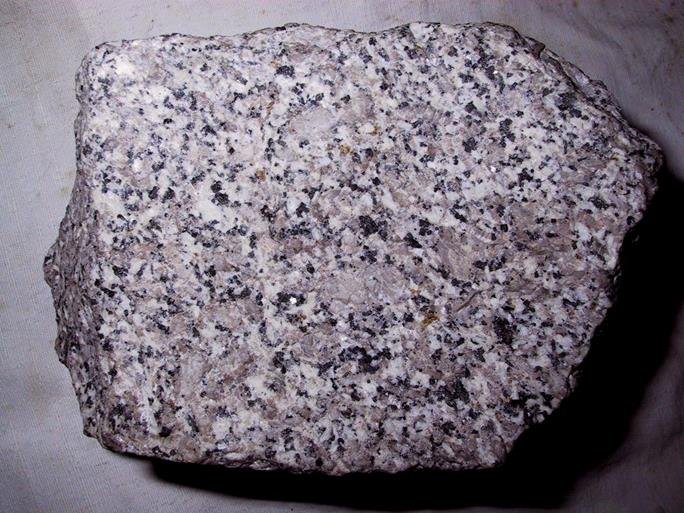Monzonite is a coarse-grained, plutonic, or intrusive igneous rock with an intermediate composition.
Plutonic or intrusive rocks form deep inside the Earth’s crust, where cooling is slow, allowing coarse grains to form.
Conversely, intermediate rocks contain 52–63 wt.% silica and moderate content of mafic and felsic minerals or elements.
Mafic rocks are rich in iron, magnesium, and darker elements, while felsic rocks are high in lighter elements like silicon, aluminum, oxygen, sodium, and potassium.

Description and properties
Monzonite is a massive, hard, coarse-grained rock with a Mohs scale of hardness of 6-7 and a density of 2.7 to 2.9 g/cm3.
Its color ranges from light to mesocratic and varies from off-white to shades of gray with some pink, bronze, brown, or greenish hue. These colors come from the various minerals the rock has.
Monzonite texture is coarse-grained with lighter-colored and darker-colored speckles. The lighter-colored speckles are feldspars like andesine, oligoclase, or orthoclase, while the darker ones are mafic minerals like hornblende, augite, or biotite.
However, it can have other textures, including porphyritic and perthitic textures.
Porphyritic monzonite has large, well-formed crystals or phenocrysts of zoned plagioclase, orthoclase, or alkali feldspar in finer but phaneritic matrix or groundmass.
The groundmass will have this mineral and others like hornblende, biotite, and sometimes, olivine, quartz, pyroxene, and accessory minerals.
On the other hand, perthitic texture forms when sodium plagioclase exists in the K-feldspar host. In contrast, antipathetic is when K-feldspar exsolves in the sodium plagioclase host.
Chemical composition
Monzonite is an intermediate rock with moderate silica content averaging at 59 wt.%. These rocks are relatively high in alkalis sodium and potassium oxides and lower in iron and magnesium oxides.
Mineral composition
Monzonite has approximately equal amounts of alkali feldspar and plagioclase, with minor biotite and hornblende. Also, it may be a small amount of quartz, olivine, and pyroxene, especially augite and/or diopside.
Accessory minerals in this rock are zircon, Fe-Ti oxides, apatite, sphene, allanite, and rarely kaersutite.
In these rocks, the plagioclase is andesine to oligoclase, while alkali feldspar is orthoclase or sometimes microcline.
On the QAPF classification, monzonite is a plutonic rock in which quartz is less than 5% of the QAPF content by volume, and alkali feldspar accounts for 35-65% of the total feldspar.
An increase in quartz to between 5% and 20 % of the QAPF content by volume grades this to quartz monzonite.
On the other hand, foid-bearing monzonites have feldspathoid accounting for up to 10% of the QAPF volume by volume.
Replace the word foid with the specific feldspathoid(s) the rock has. For instance, you can have leucite or nepheline-bearing monzonite.
Lastly, increasing alkali grades this rock into syenite and reducing it to monzodiorite.
How does monzonite form?
Monzonite forms from the slow cooling of magma in plutons deep inside the Earth’s crust. Cooling is slow, favoring the formation of a coarse-grained texture.
Erosion over a long time or uplift is what exposes this rock to the Earth’s surface.
Magma that forms this rock rocks forms from the fractional crystallization of basaltic magma formed in the mantle with or without subcrustal contamination.
Also, these magmas can form from partial melting or anatexis of gabbroic rocks or magma mixing.
Where does Monzonite occur?
Monzonite occurs in convergent continental volcanic arcs where oceanic crusts subduct beneath continental boundaries or where continental-continental plates collide.
However, minor amounts can occur in other tectonic plate settings, with minor amounts found in islands like Fiji and the Islands of the Koro.
It forms a minor part of stocks, batholiths, dikes, sills, or lopoliths with granites, diorite, quartz-diorite, and, less often, gabbro rocks. Most orogenic belt batholiths will have monzonite.
In the US, monzonite occurs in Bingham Canyon Mine in Utah, Pikes Peak Batholith in Utah, Red Mountain pluton in Alaska, and Coastal Maine Magmatic Province.
Other places with these rocks are parts of China, Iran, Norway, East Greenland, and Northwest Scotland.
Besides Earth, it occurs on the moon.
What are the uses of monzonite?
Monzonite is a hard, durable rock. Uses include making aggregate, dimensional stones, landscaping, etc.
For instance, crushed monzonite makes aggregate for the roading industry, railroad ballast, fill, subbase, etc. More uses include gravel unpaved patios, driveways, or walkways. However, this aggregate isn’t suitable for concrete due to the higher silica content.
On the other hand, monzonite is a commercial granite in the dimensional stone industry. These cut and polished stones make houses, monuments, pavers, curbing stones, countertops, windowsills, stair treads, slabs, tiles, sculptures, carvings, etc.
Some monzonite and diorite intrusions may host copper porphyry deposits or minerals like molybdenum and zinc. A good example is the Kennecott Copper Mine in Utah, US, which has copper porphyry deposits.
Frequently Asked Questions (FAQs)
It refers to medium-grained monzonite or micromonzonite, or sometimes microsyenite. Ankerite is a subvolcanic rock (formed at depths less than 2 km from the surface), and its texture is phaneritic but of medium grains, not coarse.
It is a melanocratic monzonite with zoned plagioclase and interstitial alkali feldspar from Kentallen Quarry in the UK. It also has a minor amount of olivine. augite, biotite, and greenish biotite.
Mangerite is an enstatite-bearing monzonite named after Manger in Norway. It has up to 10% enstatite and occurs with anorthosite, norite, rapakivi granite, and charnockite.
No. It is an uncommon rock. However, many rocks with nearly equal alkali feldspar and plagioclase use ‘monzo’ in their name.
